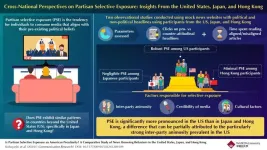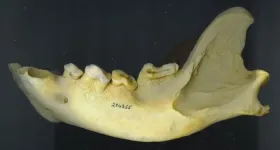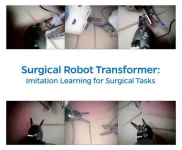(Press-News.org)
In our digital age, with easy access to a vast array of information, one would think that readers would naturally be exposed to a wide range of perspectives. However, the opposite seems to be happening, especially in countries like the United States (US), where people often seek out news that reinforces their existing beliefs and avoid content that challenges them. This tendency, known as partisan selective exposure, has been linked to increasing divides and tensions between different ideological groups. But is this behavior unique to the US, or is it a universal phenomenon driven by common psychological tendencies?
To answer this, a cross-national study was conducted led by Professor Tetsuro Kobayashi from the School of Political Science and Economics at Waseda University accompanied by Ling Liu from Waseda University, and Zhifan Zhang from Pennsylvania State University. This study examined how news consumption differs among individuals in the US, Japan, and Hong Kong. Their work was published online on October 10, 2024, in Communication Research.
Sharing their motivation for the study, Kobayashi explains, “Since political communication research is predominantly US-centric, there is a tendency to apply American findings directly to the Asian context. Our study challenges such a tendency and demonstrates the importance of conducting research that is specifically tailored to the Asian context.”
The researchers created mock news websites that presented participants with political and non-political headlines, giving them the option to select stories that either matched or contradicted with their political beliefs. They also analyzed the time spent on reading those articles.
The findings revealed that while Americans were more likely to choose news supporting their views, this behavior was less pronounced in Japan and Hong Kong.
“In the US, this selective exposure is fueled by several factors,” explains Kobayashi. “The country has a highly polarized and emotionally divided political environment, and many news outlets have clear political leanings.”
Over time, informational "echo chambers" facilitated by selective exposure can intensify political differences, fueling division and making it more difficult for people with opposing views to have meaningful conversations.
In contrast, Japan’s political climate is less polarized, and its news outlets are generally less partisan. Because these “echo chamber” tendencies are weaker, opposing groups may benefit from a more balanced flow of information, fostering a political climate that is less divided. Hong Kong presents a more complex case due to its unique political and media environment, but selective exposure there is still weaker than in the US.
“Our research challenges the assumption that selective exposure is just a natural human tendency driven by psychology,” adds Kobayashi. “Beyond the desire to avoid cognitive dissonance, our results suggest that the media and political environment of a country play a critical role in shaping how individuals engage with news.”
This raises important questions about how to design online and offline environments to encourage people to engage with a wider range of viewpoints, which could help reduce political polarization. Understanding why this behavior is more common in some countries than others can help guide efforts to improve the way people consume news. We hope this study paves the way for more advanced research tailored to Japan.
***
Reference
DOI: 10.1177/00936502241289109
Authors: Tetsuro Kobayashi1, Zhifan Zhang2, and Ling Liu1
Affiliations
1Waseda University, Shinjuku-ku, Tokyo, Japan
2Pennsylvania State University, University Park, USA
About Waseda University
Located in the heart of Tokyo, Waseda University is a leading private research university that has long been dedicated to academic excellence, innovative research, and civic engagement at both the local and global levels since 1882. The University has produced many changemakers in its history, including nine prime ministers and many leaders in business, science and technology, literature, sports, and film. Waseda has strong collaborations with overseas research institutions and is committed to advancing cutting-edge research and developing leaders who can contribute to the resolution of complex, global social issues. The University has set a target of achieving a zero-carbon campus by 2032, in line with the Sustainable Development Goals (SDGs) adopted by the United Nations in 2015.
To learn more about Waseda University, visit https://www.waseda.jp/top/en
About Professor Tetsuro Kobayashi
Dr. Tetsuro Kobayashi is a Professor of Political Science at Waseda University, Japan. His research focuses on political communication, political psychology, and public opinion. He earned his Ph.D. in social psychology from the University of Tokyo in 2009. Before joining Waseda University, he held positions at the National Institute of Informatics and City University of Hong Kong.
END
A new study led by Dr. Jack Tseng and published in PeerJ Life & Environment has shed light on the intricate relationship between tooth wear and jaw mechanics in highly carnivorous mammals, known as hypercarnivores. As mammalian teeth do not regenerate, these animals often face declining bite efficiency as their teeth wear down over time. This research explores how different hypercarnivorous species, including scavengers, meat specialists, and bone-cracking predators, adapt biomechanically and possibly behaviorally to manage the challenges posed by tooth wear.
The ...
A robot, trained for the first time by watching videos of seasoned surgeons, executed the same surgical procedures as skillfully as the human doctors.
The successful use of imitation learning to train surgical robots eliminates the need to program robots with each individual move required during a medical procedure and brings the field of robotic surgery closer to true autonomy, where robots could perform complex surgeries without human help.
“It’s really magical to have this model and all we do is feed it camera input and it can predict the robotic ...
Madeleine and Paul are sitting on a park bench. As she tells Paul about her financial worries and how she’s been struggling for months to make ends meet, Madeleine’s eyes well with tears. Paul is moved by her distress; her woes resonate with him and heighten his own fears. His heart grows heavy and his own eyes become moist, too.
What’s going on? A kind of behavioural mirroring, what psychologists call “emotional contagion.”
“Just as some people are more likely to catch a respiratory virus through close contact, others are more susceptible to ‘catching’ the emotions of the people around them,” explained Marie-Josée ...
Research Highlights:
Fear of another heart attack was a significant ongoing contributor to how heart attack survivors perceive their health, according to a new study.
While anxiety and depression are recognized as common conditions after a heart attack, they did not explain the impact of fear of recurrence in this study.
The researchers suggest that fear of another heart attack should be evaluated and addressed separately from depression and anxiety.
Note: The study featured in this news release is a research abstract. Abstracts presented at the American ...
Research Highlights:
A small survey of adults aged 30 to 89 (average age of 65) in Sweden who have heart conditions found that there is a significant difference between the sexual health information they seek and what is provided to them by their health care professionals and the health care system.
Despite 76% of patients with heart conditions reporting that sexual health affects their mood and well-being, only 5% received information or counseling about sexual health.
Researchers suggest health care professionals adjust their patient care practices to ensure that discussing sexual health becomes a standard and respected topic in health ...
Research Highlights:
Heart disease, Type 2 diabetes, high blood pressure and obesity were more common and linked to reduced access to healthy food among people who lived in neighborhoods previously subjected to structural racism-based policies that limited home ownership — an outlawed practice known as redlining.
Researchers say testing interventions to help improve access to healthy food or boost social and economic resources could mitigate the still-present impact of outdated policies like redlining.
Note: The study featured in this news release is a research abstract. Abstracts presented at American Heart Association’s scientific meetings are not peer-reviewed, and the ...
Research Highlights:
Scientists conducted a simulation study to estimate the impact of cardiovascular-kidney-metabolic (CKM) syndrome on cardiovascular disease (CVD) risk prediction.
The study found that adults with chronic kidney disease would have elevated CVD risk eight years earlier than those without the disease. In addition, people with Type 2 diabetes would have an elevated CVD risk about a decade sooner than those without it.
Among adults with both Type 2 diabetes and chronic kidney disease, women ...
Research Highlights:
A version of the Multi-Ethnic Study of Atherosclerosis (MESA) heart disease risk score that did not include race predicted heart disease risk just as well as the original version that includes race.
The original MESA risk score, developed in 2015[1], combines traditional risk factors, sex and race with a coronary artery calcium score.
The MESA formula without race may be used for people who identify with more than one racial or ethnic group or those who prefer not to disclose their race or ethnicity.
Note: The study featured in this ...
This news release contains updated information and data not included in the abstract.
Research Highlights:
The sooner a lay rescuer (bystander) starts cardiopulmonary resuscitation (CPR) on a person having a cardiac arrest at home or in public, up to 10 minutes after the arrest, the better the chances of survival and brain protection, according to an analysis of nearly 200,000 out-of-hospital cardiac arrest cases in the U.S. from 2013 to 2022.
Among the study’s findings, people who received CPR within two minutes of out-of-hospital cardiac arrest had 81% higher odds of survival to release from the hospital ...
Research Highlights:
A study of nearly 2,400 cardiac arrest cases in North Carolina found that when emergency dispatchers (telecommunicators) provided cardiopulmonary resuscitation (CPR) instructions to 911 callers, people were more likely to provide aid for both men and women.
The study’s findings indicate that when a telecommunicator provided assistance to callers, bystander CPR was performed 44% of the time on women and 40% on men, compared to 9% on women and 11% on men when telecommunicator assistance was not provided.
Researchers found the telecommunicator role critical in instructing bystanders to act quickly, possibly instrumental in reducing sex disparities ...


